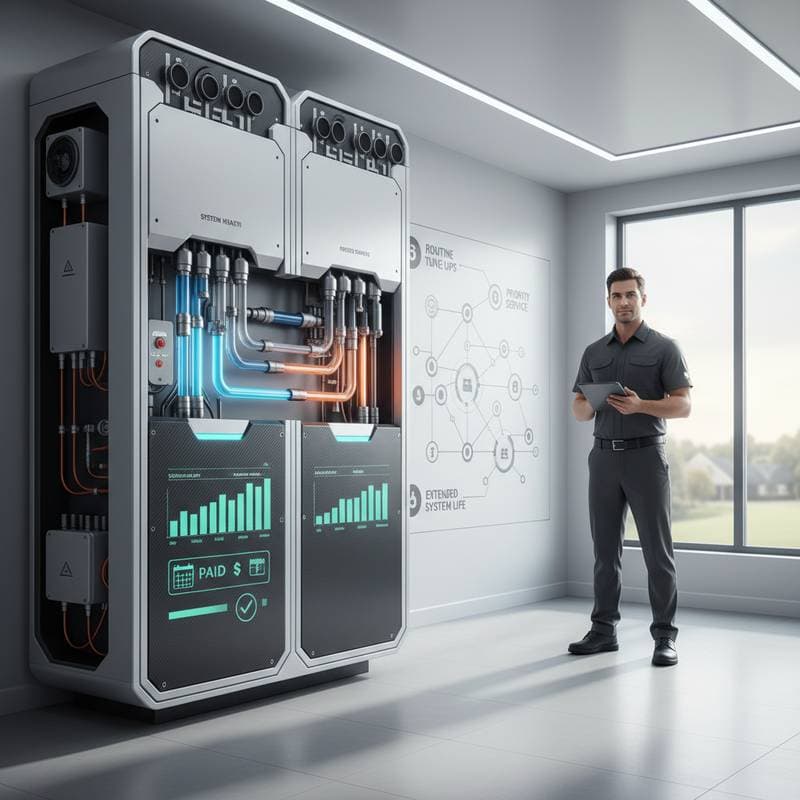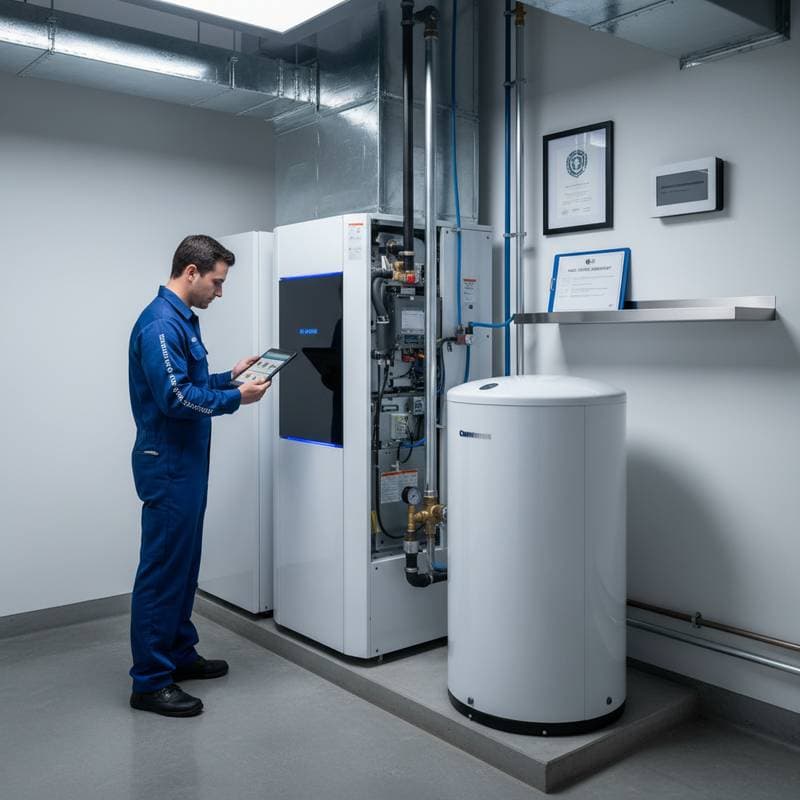How Smart Sensors Prevent $8,000 in HVAC Water Damage
An overlooked condensate leak in an HVAC system can silently inflict thousands of dollars in water damage. Homeowners typically face costs of approximately $8,000 to restore floors, drywall, and insulation following such an incident. Smart HVAC sensors provide an effective solution to avoid this financial burden. These devices identify leaks at their onset, issue prompt notifications, and enable swift intervention to contain the issue. This guide details the operation of smart HVAC sensors, their pricing, and the rationale for considering them a valuable enhancement to home protection.
| Item | Average Cost |
|---|---|
| Smart HVAC Leak Sensor | $50 - $200 |
| Professional Installation | $100 - $300 |
| Average Water Damage Repair (Without Sensor) | $5,000 - $8,000 |
| Potential Savings | Up to $7,500+ |
Average Costs for Smart HVAC Sensors
Smart HVAC sensors vary in design and functionality, which influences their price. Entry-level leak detectors begin at $50, whereas sophisticated Wi-Fi models that monitor temperature, humidity, and flow reach up to $200. Adding professional installation contributes $100 to $300, based on the configuration of the system.
The following table summarizes costs for prevalent options:
| Sensor Type | Typical Price Range | Key Features |
|---|---|---|
| Basic Condensate Leak Sensor | $50 - $80 | Detects water in drain pan, activates alarm |
| Wi-Fi Smart Leak Sensor | $90 - $150 | Delivers phone notifications, compatible with smart home applications |
| Comprehensive HVAC Monitoring Kit | $150 - $200 | Oversees temperature, humidity, and condensate flow |
| Professional Installation | $100 - $300 | Encompasses testing and calibration |
The overall expense to secure the system often falls below the deductible of standard homeowner insurance policies, positioning it as a prudent financial choice.
Factors Influencing Smart Sensor Pricing
Multiple elements determine the ultimate cost of a smart HVAC sensor setup. Grasping these aspects assists in selecting appropriate protection suited to the residence.
Sensor Technology
Fundamental sensors rely on basic moisture detection, whereas advanced models incorporate wireless communication, temperature measurement, and diagnostic forecasting. Additional capabilities elevate the cost.
Connectivity and Integration
Devices that link to Wi-Fi or synchronize with platforms such as Alexa or Google Home command higher prices, yet they deliver notifications regardless of location. Such integration often distinguishes minor repairs from substantial water harm.
Power Source and Upkeep
Battery-operated sensors offer placement flexibility and straightforward setup, in contrast to wired variants that demand greater effort but eliminate battery changes. Considerations of battery duration and upkeep remain minimal for sustained operation.
Installation Demands
Accessing an HVAC unit in confined spaces like attics or crawlspaces increases complexity and time. Professionals typically incorporate calibration and verification, which increment labor expenses while guaranteeing precision.
Varieties of HVAC Leak Detection Sensors
HVAC leak sensors exist in diverse forms, tailored to particular systems and user needs.
Condensate Pan Sensors
- Pros: Economical and uncomplicated; activates alarm upon water pooling
- Cons: Lacks remote notifications without a smart hub connection
Wi-Fi Smart Leak Detectors
- Pros: Provides immediate phone alerts, logs system information, and may automatically halt operations
- Cons: Depends on Wi-Fi availability and application configuration
Inline Condensate Drain Sensors
- Pros: Identifies obstructions promptly, averts overflows, and suits high-efficiency units
- Cons: Involves elevated expense and potential need for expert placement
Multi-Sensor Systems
- Pros: Supervises various zones including attics, basements, and the HVAC unit
- Cons: Carries higher costs and necessitates integrated configuration
Selection hinges on the system's vintage, placement, and desired level of automation.
Indicators for Installing a Smart Leak Detection System
Despite apparent normal operation of the HVAC, certain signals indicate the benefit of adding a smart leak sensor.
- Moisture or damp areas near the furnace or air handler
- Musty odors emanating from vents
- Rust or deterioration on drip pans or coils
- Recurrent blockages in condensate drains
- Sudden increases in indoor humidity
- Water marks on ceilings under attic-mounted HVAC units
Presence of these signs points to potential vulnerability to leaks or overflows.
Installation Procedure for Smart HVAC Sensors
The process of installing a smart HVAC sensor proves manageable, though expert involvement assures dependability. The sequence unfolds as follows:
- System Evaluation: A specialist examines the HVAC unit, drain lines, and condensate pan for existing or impending leaks.
- Sensor Positioning: Placement occurs adjacent to the condensate drain pan or within the drain line at high-risk points.
- Connectivity Establishment: Wi-Fi models connect to the router and corresponding application.
- Verification: Simulation of a leak confirms proper alert activation.
- Calibration: Sensors tracking temperature or flow adjust for precise measurements.
- User Guidance: Instructions cover alert interpretation, sensor resetting, and routine maintenance.
Expert installation generally requires under one hour and integrates seamlessly with the current HVAC arrangement.
Labor Expenses for Smart HVAC Sensors
Installation labor for smart HVAC sensors spans $100 to $300, varying with system intricacy and access. Technicians frequently pair this with routine maintenance or seasonal servicing. Certain providers bundle sensor placement into comprehensive leak prevention plans, yielding long-term economies.
The merit of professional service resides in optimal positioning and stable connections. Incorrect setup risks missed detections or erroneous warnings. Proper execution instills assurance in comprehensive system safeguarding.
Frequently Asked Questions About Smart HVAC Sensors
How do smart HVAC sensors avert water damage?
Smart sensors identify water accumulation or obstructed condensate lines prior to overflow. Upon detecting moisture, they activate an alarm or app notification, allowing system shutdown or prompt assistance.
Is self-installation feasible for a smart leak detector?
Certain models support do-it-yourself placement, particularly battery-powered units with adhesive mounts. For units in inaccessible spots or integrated systems, professional service ensures steadfast performance.
Do smart leak sensors necessitate Wi-Fi?
Basic models operate with local alarms only. Advanced variants leverage Wi-Fi for mobile alerts. Wi-Fi functionality enhances reassurance, particularly during absences from home.
What is the recommended testing frequency for leak sensors?
Seasonal testing verifies sensor and alarm efficacy. Introduce a modest volume of water to the condensate pan and observe alert triggering.
Can these sensors automatically deactivate the HVAC system?
Select advanced units interface with a cutoff mechanism to suspend operations upon leak detection. This capability curbs additional water buildup and minimizes harm.
Proactive Measures to Shield Your Home from Water Threats
Integrating smart HVAC sensors represents a forward-looking strategy to preserve property integrity and financial stability. These devices transform potential disasters into manageable situations through timely awareness. Homeowners gain enduring value from this investment, ensuring comfort without the shadow of unforeseen repairs.





